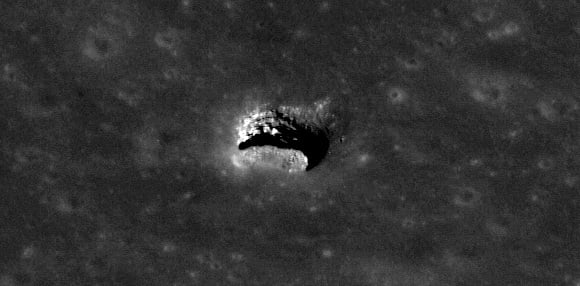This article is more than 1 year old
Elon Musk's rocket booked by Google X-Prize moon robot
Falcon 9 to carry rover to historic Apollo 11 site
By lucky hap NASA's moon-mapper sat has just discovered a handy refuge from ion storms, meteorites etc
The frozen polar ices could be valuable even in the absence of a manned Moonbase, however, as they would also be a potential source of rocket fuel that wouldn't have to be hauled up through the Earth's cripplingly powerful gravity well and our inconvenient (for rockets) atmosphere. This fuel could propel returning moon missions, allowing much more payload to be carried on outbound journeys.

An ideal spot for getting away from the radiation and meteorites ...
Lunar ice-juice would also, potentially, find a ready market in Earth orbit for refuelling satellites – at the moment a pricey satellite must usually be de-orbited and destroyed when it runs low on manoeuvring fuel. Successful refuelling trials have been carried out using fuel sent up from Earth, but this is so costly that so far nobody has found it a worthwhile technique to actually use. Lunar fuel, needing to be lifted from a gravity only one-sixth that of Earth and without the need to fight through atmospheric drag, might one day change this situation.
For now, Astrobotic has a small NASA contract to design a mining robot which could brave the perishing sunless depths of the polar craters to recover their valuable frozen volatiles – or anyway, dig for possible deposits of buried ices in that region, which would be easier than delving into the crater deeps proper. The firm also has plans to "explore 'skylight' holes and lunar caves as havens from temperature extremes, radiation exposure and micrometeorite bombardment".
Caverns and caves might offer a refuge from the various hazards of the lunar surface: not just the paralysingly cold nights, but the periodic radiation storms which belch out from the Sun – potentially killing any human exposed to them. (Thus far the only people ever to run this risk have been the Apollo astronauts on their brief journeys: all other human beings who have ever lived, including astronauts and cosmonauts in orbit, have remained within the protective blanket of the Earth's magnetic field.)
Micrometeorites would also be a serious issue for long-staying lunar explorers human or robotic, as there is no protective atmosphere and thus even the common small space pebble or boulder – of the sort which burn up in Earthly skies all the time – strikes the surface at terrific, deadly speed.
Construction of buildings sturdy enough to resist radiation storms and meteorites would be a big job, so it would be very handy if pre-existing caves could be used instead: all the more so as the cave interiors ought to stay at a steady temperature instead of swinging wildly between extreme cold and sunlit heat.
Fortunately, some caves at least do appear to exist – there may even be naturally-occurring subselenean tunnels formed by long-past lava flows. As it happens. NASA's moon-scanning Lunar Reconnaissance Orbiter has just managed to snap a pic (above) of a definite, visible void space lying beneath the Marius Hills of the Oceanus Procellarum ("Ocean of Storms"), one of the dark basalt plains that cover much of the near face of the Moon.
It would be an awfully long haul from an underground Moonbase in the Marius Hills to a polar ice mine, of course: NASA boffins were thinking more along the lines of a "hairy landing" on a polar crater rim when they sent up the LRO a few years back. Using the detailed, accurate maps produced by the LRO they thought that a future moon lander might manage to set down on a fortunate flat spot atop a polar crater wall.
Not only would such a lander arrive relatively close to the deposits of ice in the sunless crater deeps below, it would itself perhaps be sited in one of the few lunar locations constantly lit by the sun (the Moon not having much of an axial tilt, its poles don't get dark as ours do – the Sun simply moves round and round above the horizon). This would avoid the scourge of the freezing nights, and also provide constant solar power – avoiding the almost certain requirement for nuclear energy of some sort to sustain a base anywhere else through the nights.
Unfortunately nobody has yet managed to find a polar icecrater-rim flat spot, big enough to land a rocket on, which also has a handy cave complex close at hand: so the argument over the perfect Moonbase location continues.
Meanwhile, the moon-mad engineers at Astrobotics also have another cunning plan for dealing with the various selenean hazards: on their drawing boards is a speedy robo-rover able to circle the Moon every month. The nippy machine would thus be able to "outrun the sunset" and stay on the bright daylit side all the time.
Just how much of all this comes true remains to be seen: but with the announcement of the SpaceX launch deal it now appears that the human race may at least revisit the scene of its decades-past Apollo triumph – if only by robotic proxy. For fans of the internet, there may be some satisfaction in reflecting that the money behind the mission comes from the rise of Google and PayPal (where Musk made the fortune which got the Falcon 9 into operation).
That said, though, last time we wrote about Astrobotic in 2009 they thought they'd be landing in the Sea of Tranquillity in 2010: now it's 2011 and they say 2013. Extrapolating from that progression, the expected date for the Red Rover to follow in Armstrong and Aldrin's illustrious footsteps may move further and further away into the future. ®
